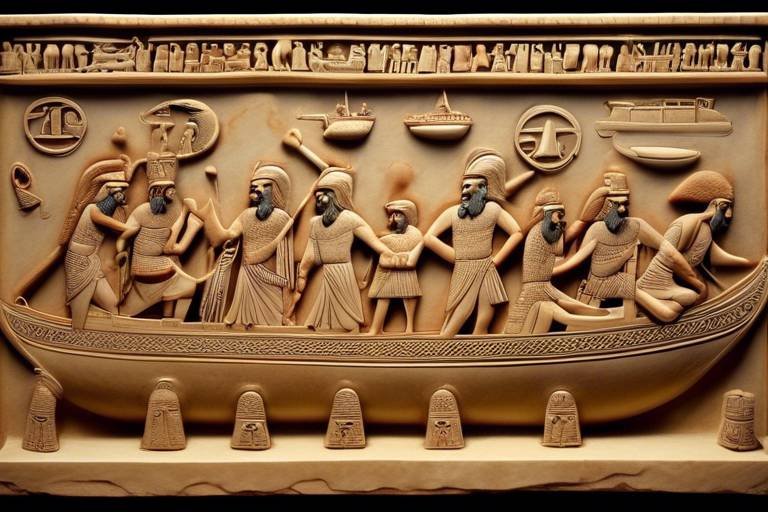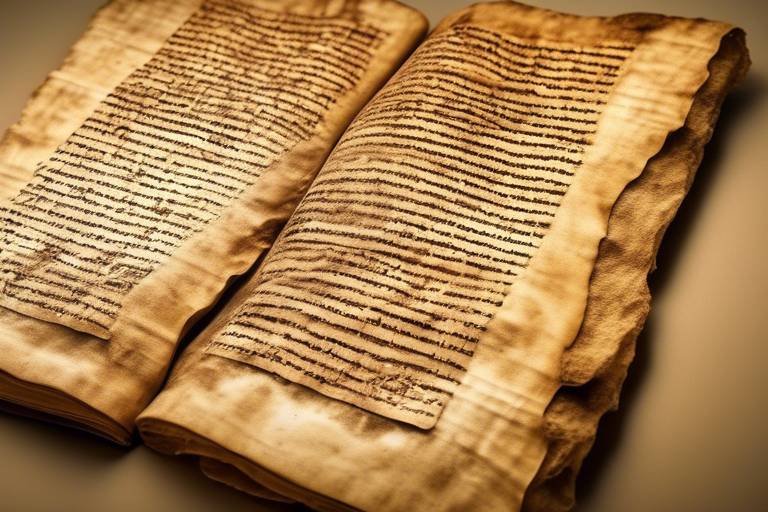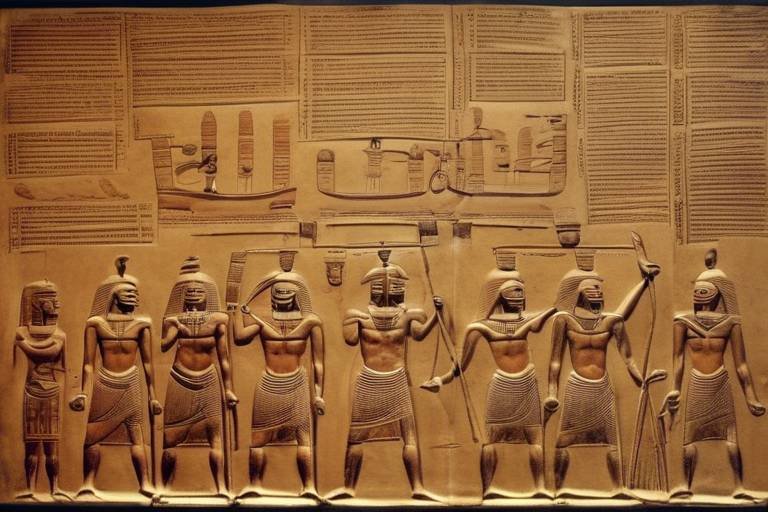The Secrets of Ancient Civilizations' Religious Beliefs
Have you ever wondered about the mystical and captivating religious beliefs of ancient civilizations? Journey with us as we uncover the secrets hidden within the mythologies, rituals, cults, gods, temples, sacrifices, symbols, and divination practices of societies long past. These ancient cultures left behind a legacy of spiritual practices that continue to intrigue and fascinate us to this day.

Egyptian Mythology and Deities
When it comes to ancient Egyptian religious beliefs, one cannot help but be mesmerized by the intricate tapestry of gods and goddesses that adorned their mythology. These deities were not just figures of worship but integral parts of everyday life for the ancient Egyptians. From the powerful Ra, the sun god, to the wise Thoth, the god of wisdom and writing, each deity played a unique role in the cosmic order.
The Egyptians believed that their gods and goddesses controlled every aspect of nature and human existence, from the flooding of the Nile to the cycle of life and death. The pantheon was vast and diverse, with each deity embodying different qualities and powers. For example, Isis symbolized motherhood and magic, while Anubis presided over mummification and the afterlife.
Moreover, the ancient Egyptians' religious practices were not confined to grand temples and rituals but permeated all aspects of their lives. Whether offering prayers to Hathor for fertility or seeking protection from Horus in times of war, the presence of the gods was felt in every corner of Egyptian society.
Through exploring the myths and legends surrounding these deities, we gain a deeper understanding of the ancient Egyptian worldview and the profound impact of their religious beliefs on art, architecture, and daily rituals.

Greek Pantheon and Rituals
The ancient Greek civilization is renowned for its intricate pantheon of gods and goddesses, each with their own unique personalities and domains. From Zeus, the powerful king of the gods, to Athena, the wise goddess of wisdom and warfare, the Greek deities played a central role in the lives of the people. These gods and goddesses were not just distant figures to be worshipped; they were believed to actively intervene in human affairs, influencing everything from the outcome of wars to the success of crops.
Rituals and ceremonies were an essential part of Greek religious practices, serving as a way to honor and appease the gods. Festivals dedicated to specific deities, such as the Eleusinian Mysteries in honor of Demeter and Persephone, were held throughout the year, drawing worshippers from far and wide. These rituals often involved offerings of food, drink, and incense, as well as prayers and hymns sung in praise of the gods.
One of the most famous rituals in ancient Greece was the Olympic Games, held every four years in honor of Zeus. These athletic competitions were not only a display of physical prowess but also a form of worship, with the victors being seen as favored by the gods. The Greeks believed that success in the games brought honor not only to the athletes themselves but also to their city-states and the deities they worshipped.
The temples dedicated to the Greek gods were grand structures, adorned with intricate carvings and statues depicting the divine figures. These temples served as both places of worship and centers of community life, hosting ceremonies, festivals, and other religious activities. Priests and priestesses played a crucial role in maintaining the temples and conducting the rituals, acting as intermediaries between the mortal world and the divine realm.
Overall, the Greek pantheon and rituals offer a fascinating glimpse into the religious beliefs and practices of one of the most influential civilizations in history. The reverence for the gods, the elaborate ceremonies, and the sense of connection between the human and divine worlds all contributed to the rich tapestry of Greek mythology and religion.

Roman Cults and Festivals
When it comes to the ancient Romans, their religious practices were far from ordinary. The Roman civilization was deeply rooted in a complex network of cults and festivals that played a crucial role in their daily lives. These cults were not your average gatherings; they were secretive societies devoted to the worship of specific deities, each with its own set of rituals and beliefs.
One of the most infamous Roman cults was the Cult of Mithras, a mystery religion centered around the god Mithras, who was believed to be a mediator between the human and divine realms. Initiates of this cult would partake in elaborate ceremonies in underground temples, symbolizing the eternal struggle between good and evil.
On the other hand, Roman festivals were vibrant and extravagant celebrations that honored various gods and goddesses. The most famous of these festivals was the Saturnalia, a week-long event in December dedicated to the agricultural god Saturn. During this time, social norms were turned upside down, with feasting, gift-giving, and general merrymaking taking precedence.
Another notable festival was the Lupercalia, a fertility celebration in honor of Lupercus, the Roman god of shepherds. This festival involved rituals where men would run through the streets striking women with strips of goat hide, believed to promote fertility and ward off evil spirits.
These cults and festivals were not just about religious devotion; they were integral to the social fabric of Roman society. They provided a sense of community and belonging, as well as an opportunity for individuals to connect with the divine forces believed to govern their world.

Mesopotamian Gods and Temples
When delving into the ancient Mesopotamian civilization, one cannot ignore the intricate web of gods and goddesses that shaped their religious beliefs. The Mesopotamians worshipped a vast array of deities, each governing different aspects of life and nature. From the powerful god of the sky, Anu, to the wise goddess of love and war, Ishtar, these divine beings played a crucial role in the daily lives of the Mesopotamian people.
The temples dedicated to these gods were not mere structures but grand architectural marvels that reflected the religious fervor of the civilization. These temples, such as the famous ziggurats, were towering edifices built with precision and adorned with intricate carvings and paintings. They served as sacred spaces where priests conducted elaborate rituals and ceremonies to honor the gods and seek their blessings.
One of the most renowned Mesopotamian temples was the ziggurat of Ur, dedicated to the moon god Nanna. This massive stepped pyramid symbolized the link between heaven and earth, with each level representing a different realm of existence. The Mesopotamians believed that these temples were the dwelling places of the gods, where mortal beings could communicate with the divine and offer sacrifices to ensure prosperity and protection.
Moreover, the Mesopotamians held festivals and celebrations throughout the year to honor their gods and goddesses. These vibrant events were marked by music, dance, feasting, and processions, showcasing the deep-rooted religious traditions of the civilization. The rituals performed during these festivals were believed to appease the deities and maintain harmony between the human world and the divine realm.
In conclusion, the Mesopotamian gods and temples stand as a testament to the spiritual richness and cultural sophistication of one of the earliest civilizations in history. The intricate pantheon of deities and the awe-inspiring temples they inspired offer a glimpse into the religious practices and beliefs that shaped the lives of the Mesopotamian people.

Mayan Cosmology and Sacrifices
The Mayan civilization, known for its advanced understanding of astronomy and mathematics, had a cosmology deeply intertwined with their religious beliefs. Central to Mayan cosmology was the concept of a multi-layered universe, with different realms inhabited by gods, ancestors, and supernatural beings. These beliefs influenced every aspect of Mayan life, from agriculture to warfare, shaping their societal structure and rituals.
One of the most controversial aspects of Mayan religious practices was their use of human sacrifices. The Mayans believed that offering human blood to the gods was essential for maintaining the balance of the universe and ensuring the continuity of life. Sacrificial rituals were performed during important ceremonies and events, with captives or volunteers chosen as offerings to appease the deities.
The Mayans saw death as a necessary part of the cosmic cycle, believing that blood sacrifices helped sustain the world and prevent disaster. These sacrifices were often elaborate and ritualistic, with priests conducting ceremonies in specially designated temples. The practice of human sacrifice, while shocking to modern sensibilities, was deeply ingrained in Mayan religious beliefs and played a significant role in their cosmology.
Moreover, Mayan cosmology was intricately connected to their calendar system, which was based on a complex interplay of astronomical observations and religious symbolism. The Mayans believed that time was cyclical, with each cycle marked by the rise and fall of civilizations, cosmic events, and the movements of celestial bodies. Their calendar not only served practical purposes but also held profound religious significance, guiding their rituals and ceremonies.
Overall, Mayan cosmology and sacrifices offer a fascinating glimpse into the religious beliefs and practices of this ancient civilization. By understanding the intricacies of their cosmological worldview and the role of sacrifices within it, we can gain valuable insights into the spiritual and cultural heritage of the Mayan people.

Indus Valley Seals and Symbols
The ancient civilization of the Indus Valley holds a mysterious allure, with its enigmatic seals and symbols offering glimpses into their religious beliefs and spiritual practices. These intricate artifacts, dating back thousands of years, have puzzled historians and archaeologists, sparking debates and theories about the civilization's rituals and customs.
The Indus Valley seals, crafted with remarkable precision, depict a variety of symbols and motifs that are still not fully understood. Some of these symbols are believed to represent animals, plants, or even deities worshipped by the ancient Indus people. The meticulous carvings on these seals suggest a sophisticated society with a deep-rooted connection to the spiritual realm.
One of the most intriguing aspects of the Indus Valley civilization is the absence of monumental temples or grandiose religious structures. Instead, their religious practices seem to have been more decentralized, possibly centered around household rituals or community gatherings. The seals and symbols may have played a crucial role in these ceremonies, serving as talismans or objects of veneration.
Researchers have identified recurring motifs on the seals, such as the famous 'Pashupati Seal,' depicting a figure seated in a yogic posture surrounded by animals. This image has led to speculations about early forms of yoga or proto-Shiva worship in the ancient Indus Valley culture. The significance of these symbols in religious ceremonies remains a subject of ongoing study and interpretation.
Furthermore, the script found on some of the seals has yet to be fully deciphered, adding another layer of mystery to the civilization's religious practices. The intricate combination of symbols and script suggests a complex system of communication and possibly ritualistic incantations, hinting at a sophisticated religious worldview.
As we unravel the secrets of the Indus Valley seals and symbols, we are reminded of the enduring legacy of ancient civilizations and their profound spiritual beliefs. These artifacts serve as windows into the past, offering tantalizing glimpses of a culture shrouded in mystery and intrigue.

Chinese Ancestor Worship and Divination
Chinese Ancestor Worship and Divination hold a significant place in the rich tapestry of Chinese religious traditions. Ancestor worship is deeply rooted in Chinese culture, where respect for one's ancestors is considered paramount. Families honor their ancestors through rituals and offerings, believing that the spirits of the deceased play a role in the lives of the living. Ancestral altars are adorned with incense, food, and other offerings as a sign of reverence and gratitude.
Divination, on the other hand, is an ancient practice used to communicate with the spirit world and seek guidance from the divine. Chinese divination methods include techniques such as casting oracle bones, interpreting dreams, and consulting the I Ching. These practices are believed to provide insight into the future and offer solutions to life's challenges.
Throughout Chinese history, ancestor worship and divination have played a crucial role in shaping religious beliefs and cultural practices. The Chinese people have a deep respect for their ancestors, believing that their spirits continue to influence the course of events in the world. Divination, on the other hand, is seen as a way to tap into the wisdom of the divine and navigate life's uncertainties.

Norse Mythology and Runes
Norse mythology is a fascinating realm filled with epic tales of gods, giants, and other mythical beings. At the heart of this ancient belief system are the powerful Norse gods such as Odin, Thor, and Loki, each with their unique characteristics and roles in the divine hierarchy. These deities are not just distant figures but embody various aspects of nature, human emotions, and cosmic forces, making them relatable to the people who worshipped them.
One of the most intriguing aspects of Norse mythology is the use of runes, a set of symbols with mystical significance. Runes were not merely an alphabet for communication but were believed to hold magical properties and were used for divination, protection, and casting spells. The intricate designs of the runic symbols were etched onto objects, carved into stones, or inscribed on wooden sticks, imbuing them with spiritual power.
The Norse people revered the runes as a means of tapping into the hidden knowledge of the universe and seeking guidance from the gods. The act of casting or interpreting runes was a sacred ritual that required skill, intuition, and a deep connection to the spiritual realm. It was believed that the runes could reveal insights into one's destiny, provide answers to pressing questions, and even influence the course of events through their magical properties.
Furthermore, the use of runes was not limited to divination but extended to everyday life, where they were inscribed on personal belongings, weapons, and even buildings for protection and good fortune. The intricate intertwining of Norse mythology and runic symbolism created a rich tapestry of beliefs and practices that shaped the spiritual worldview of the ancient Norse people.
In conclusion, Norse mythology and runes offer a glimpse into a world where gods walked among mortals, and symbols held the power of magic and mystery. The stories of heroism, betrayal, and cosmic battles, intertwined with the intricate symbolism of the runes, paint a vivid picture of the religious beliefs and practices of the ancient Norse civilization.
Frequently Asked Questions
- What were the main deities worshipped in Egyptian mythology?
In Egyptian mythology, some of the main deities worshipped were Ra, the sun god; Isis, the goddess of magic and motherhood; and Osiris, the god of the afterlife and resurrection.
- What were the key rituals performed in Greek mythology?
Key rituals in Greek mythology included sacrifices to the gods, participation in festivals like the Olympic Games dedicated to Zeus, and the Eleusinian Mysteries honoring Demeter and Persephone.
- What were the secretive cults in Roman religious practices?
Roman religious practices included secretive cults like the Cult of Mithras, which involved initiation rituals and the worship of Mithras, the god of light and truth.
- How did the Maya civilization view the cosmos?
The Maya civilization viewed the cosmos as a complex system of interrelated realms, including the underworld, the earthly realm, and the heavens, each inhabited by different deities and spirits.
- What do the symbols on Indus Valley seals represent?
The symbols on Indus Valley seals are believed to represent various aspects of daily life, including animals, plants, and possibly deities or religious symbols, though their exact meanings remain a subject of debate among historians and archaeologists.
- Why was ancestor worship important in Chinese religious traditions?
Ancestor worship was important in Chinese religious traditions as it was believed that honoring one's ancestors ensured their continued protection and blessings, as well as maintaining familial harmony and prosperity.
- What role did runes play in Norse religious beliefs?
Runes were symbols with magical properties in Norse religious beliefs, used for divination, protection, and communication with the gods. They were considered sacred and held deep significance in Norse mythology.



















